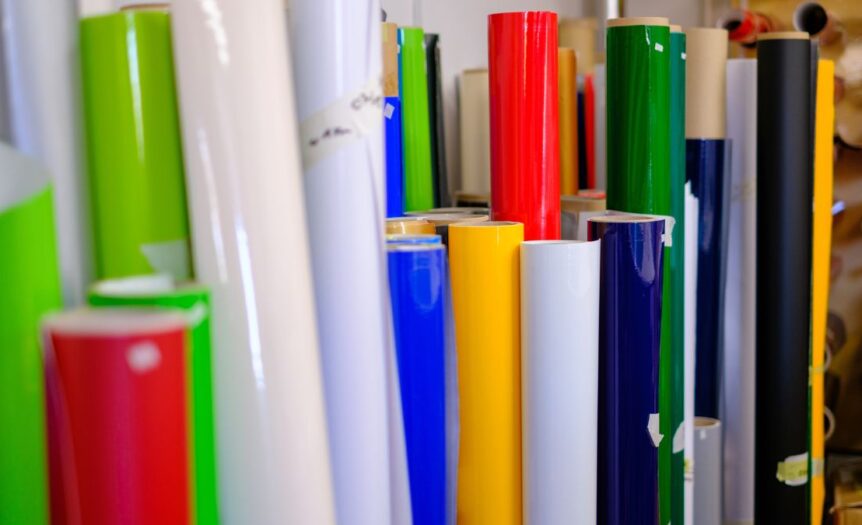Heat transfer vinyl is a thin, plastic material that adheres to t-shirts or other fabric through a combination of heat and pressure. Vinyl is a popular choice for making custom t-shirts for a business, sports team, or just for fun. Here are some pros and cons of using heat transfer vinyl on shirts that you may want to know about.
Pro: Looks Great
One of the most notable advantages of heat transfer vinyl is that it looks great. Most manufacturers make or upload the design onto a computer and print it out from there. This process ensures that the pattern is clear and has a high resolution that looks fantastic on a t-shirt.
Con: Requires Extra Care
A notable downside with heat transfer vinyl is that you have to be more careful when taking care of it. For example, you can’t iron heat transfer vinyl because that can warp and damage the material. Carelessly washing and drying shirts are some of the biggest mistakes to avoid with heat transfer vinyl. You can take steps to help the fabric last. But otherwise, it may start to peel or chip away.
Pro: Cost Effective
When looking at the pros and cons of using heat transfer vinyl on shirts, the cost is something that may come up in both categories. HTV shirts are a fantastic, cost-effective option if you’re doing a small print run or just making a few shirts for you and your friends or coworkers. However, there may be better choices for large-quantity print runs due to the time and material costs of HTV.
Con: Rubbery Feel
Some people dislike HTV on shirts because it has a distinct rubbery feel compared to screen printing or other design options. The printer ink coverage on your HTV design typically doesn’t impact how wearing the shirt feels, but the design may feel a bit peculiar to the touch when you fold it or otherwise handle it.





 Deering Estate
Deering Estate
 Massage Envy South Miami
Massage Envy South Miami
 Calla Blow Dry
Calla Blow Dry
 My Derma Clinic
My Derma Clinic
 Sushi Maki
Sushi Maki
 Sports Grill
Sports Grill
 The Healthy Kitchen
The Healthy Kitchen
 Golden Rule Seafood
Golden Rule Seafood
 Malanga Cuban Café
Malanga Cuban Café

 Kathleen Ballard
Kathleen Ballard
 Panter, Panter & Sampedro
Panter, Panter & Sampedro
 Vintage Liquors
Vintage Liquors
 The Dog from Ipanema
The Dog from Ipanema
 Rubinstein Family Chiropractic
Rubinstein Family Chiropractic
 Your Pet’s Best
Your Pet’s Best
 Indigo Republic
Indigo Republic




 ATR Luxury Homes
ATR Luxury Homes


 2112 Design Studio
2112 Design Studio
 Hamilton Fox & Company
Hamilton Fox & Company
 Creative Design Services
Creative Design Services
 Best Pest Professionals
Best Pest Professionals
 HD Tree Services
HD Tree Services
 Trinity Air Conditioning Company
Trinity Air Conditioning Company
 Cisca Construction & Development
Cisca Construction & Development
 Mosquito Joe
Mosquito Joe
 Cutler Bay Solar Solutions
Cutler Bay Solar Solutions


 Miami Royal Ballet & Dance
Miami Royal Ballet & Dance
 Christopher Columbus
Christopher Columbus
 Pineview Preschools
Pineview Preschools
 Westminster
Westminster
 Carrollton
Carrollton
 Lil’ Jungle
Lil’ Jungle
 Frost Science Museum
Frost Science Museum
 Palmer Trinity School
Palmer Trinity School
 South Florida Music
South Florida Music
 Pinecrest Orthodontics
Pinecrest Orthodontics
 Dr. Bob Pediatric Dentist
Dr. Bob Pediatric Dentist
 d.pediatrics
d.pediatrics
 South Miami Women’s Health
South Miami Women’s Health

 The Spot Barbershop
The Spot Barbershop
 My Derma Clinic
My Derma Clinic




 Miami Dance Project
Miami Dance Project

 Rubinstein Family Chiropractic
Rubinstein Family Chiropractic
 Indigo Republic
Indigo Republic

 Safes Universe
Safes Universe
 Vintage Liquors
Vintage Liquors
 Evenings Delight
Evenings Delight





 Atchana’s Homegrown Thai
Atchana’s Homegrown Thai
 Baptist Health South Florida
Baptist Health South Florida

 Laser Eye Center of Miami
Laser Eye Center of Miami
 Visiting Angels
Visiting Angels
 OpusCare of South Florida
OpusCare of South Florida

 Your Pet’s Best
Your Pet’s Best





 HD Tree Services
HD Tree Services
 Hamilton Fox & Company
Hamilton Fox & Company


 Creative Design Services
Creative Design Services